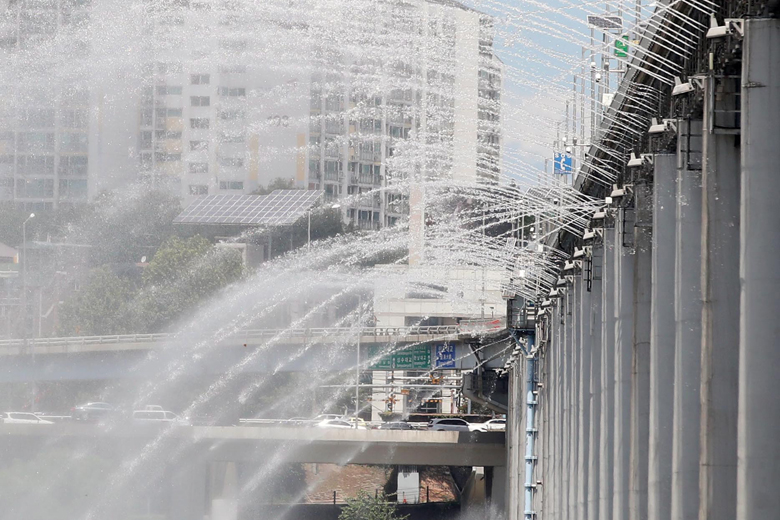Extreme heatwave in South Korea to peak in coming days
Sign up now: Get insights on Asia's fast-moving developments

Water is sprayed amid sweltering heat at the Banpo Bridge over the Han River in Seoul on July 30, 2018.
PHOTO: EPA-EFE
Follow topic:
SEOUL (THE KOREA HERALD/ASIA NEWS NETWORK) - The extreme heat wave gripping the Korean Peninsula is forecast to reach its highest temperature in the coming days, South Korea's state weather agency said on Tuesday (July 31).
While the daytime high in Seoul rose to 38.3 degrees Celsius around 3pm local time (2pm Singapore time) on Tuesday, the figure is likely rise to 39 deg C on Wednesday, the highest temperature in the city since the government started compiling the data in 1907, according to the Korea Meteorological Administration (KMA).
On Tuesday, KMA issued additional extreme heat wave warnings for Gyeongju and Cheongsong in North Gyeongsang province. The warnings had been issued in almost all regions across the country as the daytime highs rose to over 35 deg C for past few days.
Twenty-seven people have died of heat stroke and more than 2,200 people have been taken to the hospital for heat-related conditions as of Tuesday, according to the Korea Centres for Disease Control and Prevention.
This year's number of heat casualties appears to have jumped from last summer when 1,574 patients and 11 deaths related to heat were reported.
South Koreans are also enduring days of tropical nights, during which the lowest temperature remains above 25 deg C from 6pm to 9am the next day.
The blistering heat wave with daytime highs hovering around 35 deg C is to continue until the end of this week, according to the weather agency. The temperature is 4 to 7 deg C higher than the last year's average summer temperature.
"Usually, we see the hottest days early to mid-August. So the hot weather is likely to continue," an official from the KMA told The Korea Herald.
While several factors are behind the extreme heat wave this year, the main cause is the high atmospheric pressure from northern China and southern Mongolia which has expanded to reinforce the North Pacific anticyclone, the official explained.
"Being under high atmospheric pressure means the air from above circulates downward. And because of the clear skies, the air is heated and the cycle has repeated, resulting in the high temperatures," the official said.
In the Cabinet meeting Tuesday, Prime Minister Lee Nak-yon ordered a review of lowering the price of electricity for the socially disadvantaged, viewing the extreme weather condition as a "special disaster" situation.
Interior and Safety Minister Kim Boo-kyum also called for all administrative efforts to be put toward protecting those vulnerable to the hot weather, such as the elderly and said the ministry will designate special agents to check on them.
The minister also ordered active promotion of a campaign which recommends people call their parents to check how they are doing and talk to them about preventing heat-related problems.
Regional governments are also moving to check their heat-related policies, including Seoul which operates daytime heat shelters with air conditioning and monitoring of homeless in public areas.
Gyeonggi provincial government will also conduct inspections to see whether the measures to prevent heat-related accidents are appropriately implemented, in 10 cities from Wednesday until Aug 10.

